If you’re intrigued by color analysis, the Summer palette opens up an enchanting approach to personal style. This season’s cool, soft, and muted tones are perfect for those with subtle undertones and low contrast. In this guide, we’ll break down Summer color analysis in detail, highlighting its key characteristics and constituent sub-seasons. Without further ado, let’s dive right into it.

Summer Color Analysis: Key Characteristics
The Summer color analysis is defined by its cool, soft, and muted characteristics, making it one of the most delicate seasonal palettes. Below are the key characteristics in more detail:
Skin Tone
The skin tone of Summers typically has cool or neutral-to-slightly-cool undertones, often with hints of pink, blue, or purple. This undertone gives the skin a soft and delicate appearance.
Hair Color
Summer hair colors can vary widely but are generally characterized by cool or ash undertones. Shades range from light platinum blonde to medium or dark cool browns.
Even darker hair in the Summer season tends to lack warmth, maintaining a soft, muted quality. The absence of gold or red tones in the hair helps preserve the overall cool harmony of the Summer palette.
Eye Color
Eyes in the Summer season are typically soft and blended, lacking sharp contrast. Common eye colors include gentle shades of blue, green, and gray, often with a slightly cool or muted quality.
These colors tend to have a subtle, understated beauty, appearing almost hazy or diffused, which complements the other cool and soft features of this season.
Contrast and Intensity
Summers generally have low contrast between their skin, hair, and eyes, which results in a naturally harmonious appearance. The overall intensity of their coloring is mid-to-low, meaning bold or highly saturated colors can feel overwhelming.
Instead, softer and more muted tones are a better match, creating a gentle and balanced look that enhances their natural beauty.

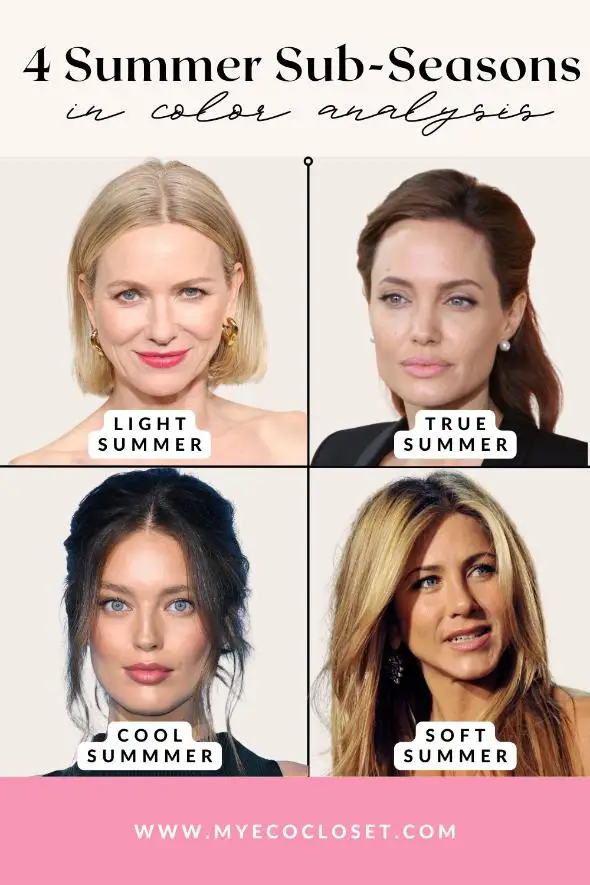
Summer Subseasons: Light, True, Soft
In the realm of summer color analysis, Summer palettes embody the soft, cool sophistication of a misty summer morning. These colors are characterized by their subtle undertones and gentle contrast levels.
Understanding the nuances between the three Summer sub-seasons — Light Summer, True Summer, and Soft Summer — is essential for anyone looking to enhance their wardrobe or personal style. Each of these categories offers a unique palette that complements specific skin tones and undertones, allowing individuals to shine in their best colors.
While the skin can range from fair to tan, it generally leans toward lighter shades with an overall cool complexion. Summers rarely have

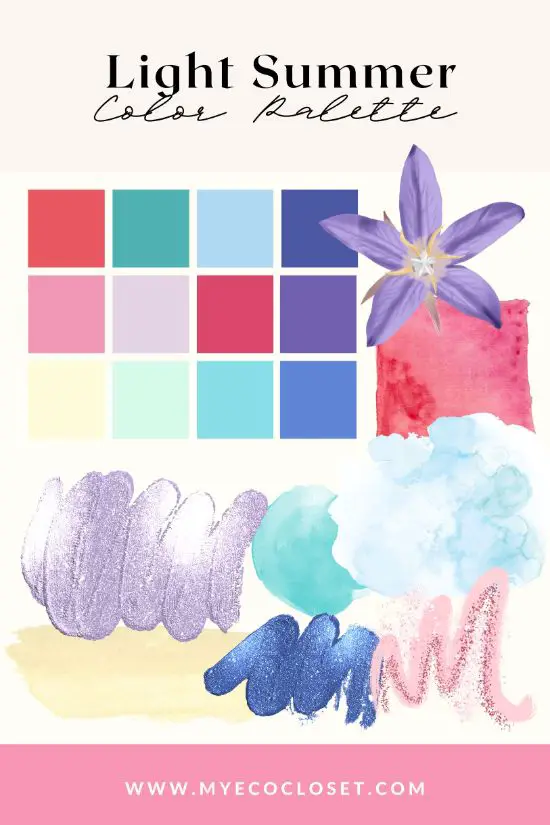
Light Summer
Light Summer is characterized by soft, muted shades with a hint of brightness. Think pastels and light neutrals that evoke a sense of freshness without overwhelming the senses. In contrast, True Summer embraces cooler hues with clarity and depth — think vibrant blues and pinks that resonate beautifully against cooler skin tones.
The following are some of the most distinctive features of the Light Summer sub-season:
- Hair typically ranges from light ash brown to baby blonde
- Eyes are usually light – pale blue, grey-blue, or light grey-green
- Skin tone is fair with cool or neutral undertones
- Overall appearance shows low contrast but with a brightened quality


Soft Summer
Then we have Soft Summer, which blends elements from both Light and True Summers. This sub-season thrives on gentle colors that are slightly muted yet maintain an air of sophistication.
Prominent Soft Summer celebrities, Bianca Balti, Jennifer Aniston, and Rihanna, showcase the muted nature of this sub-season. With low contrast between hair, skin, and eyes, these celebrities present their season as one with no boldness or stark contrasts. Their public appearances often showcase outfits in soft, muted hues that complement their naturally balanced coloring.
Given that, the Soft Summer color season is distinguished by the following:
- Hair colors tend toward mousy brown or soft ash tones
- Eyes are often mixed colors – grey-green, hazel, or soft brown
- Skin shows neutral to cool undertones with a muted quality
- Overall appearance has low contrast with a softened effect
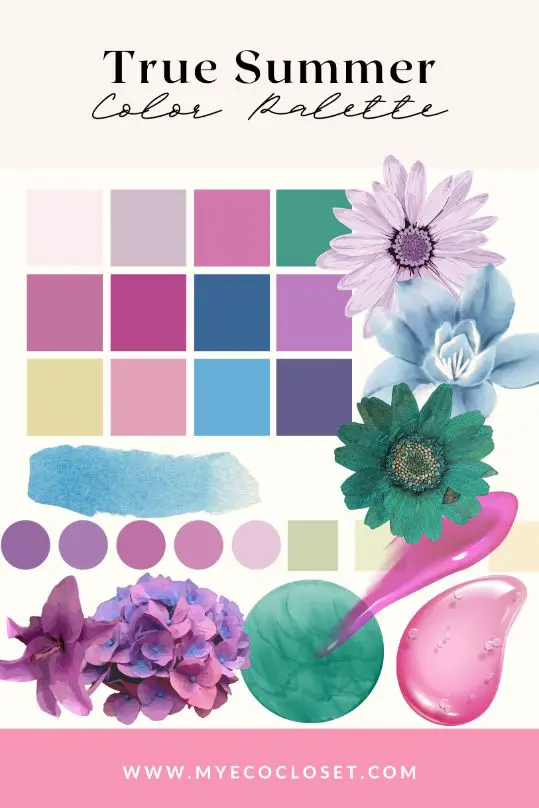

True Summer
True Summer embodies the purest expression of Summer characteristics, embodying pure coolness without any warm undertones. These individuals possess a naturally cool beauty that resonates with the soft, blue-based colors of their palette. Their coloring is like a watercolor painting – subtle, blended, and harmonious.
Key characteristics of True Summers include:
- Natural hair colors range from cool medium brown to ash blonde, often with no warmth or red undertones
- Eyes are typically cool-toned – soft blue, grey, or cool brown
- Skin has a distinctly cool undertone with no golden or peachy qualities
- Overall appearance shows medium contrast levels without any sharp distinctions
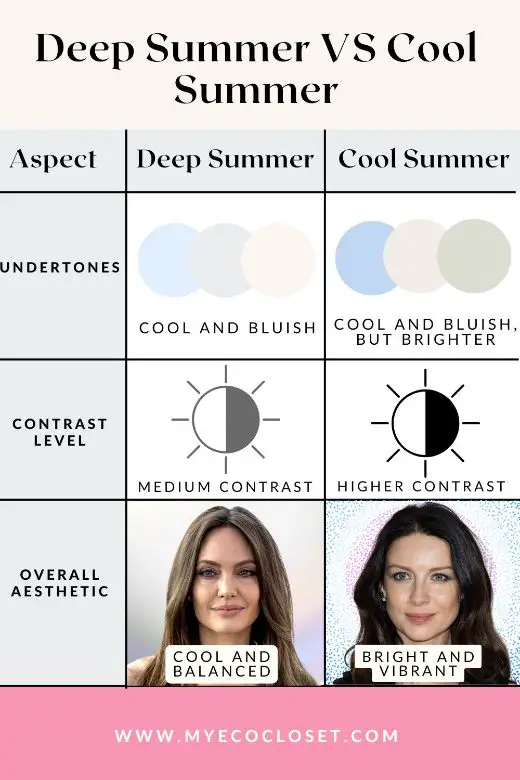
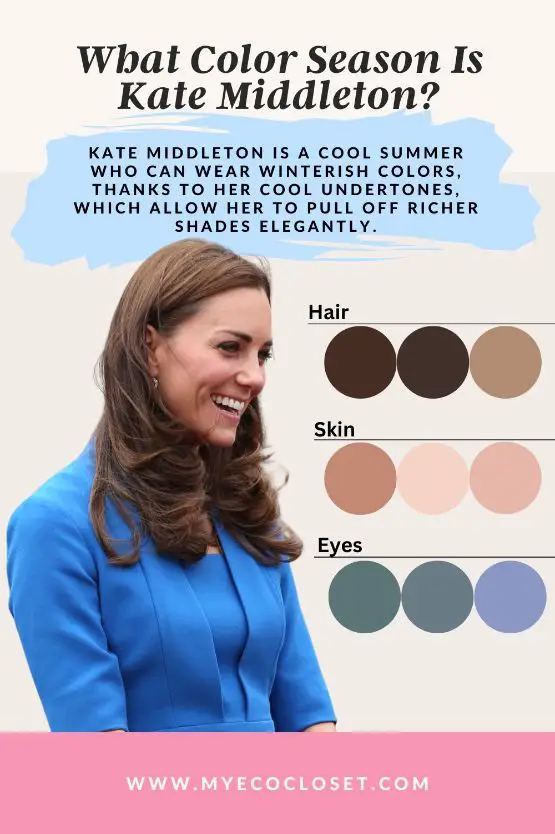
Optional: Deep & Cool Summer
While many systems focus on these three main categories, some also recognize Deep Summer or Cool Summer as distinct classifications.
At My Eco Closet, we provide in-depth guides on seasonal color analysis, and based on our conclusions, the Deep Summer sub-season is redundant and causes too much confusion. Instead, we acknowledge the following 4 sub-seasons: Soft, Light, True, and Cool Summer.
Regardless, we would like to break down these two optional sub-seasons of the color season, so that you can draw the conclusions yourself. Let’s dive in.


Cool Summer
When it comes to Cool Summers, coolness is the dominant trait. Picture this sub-season as a natural bridge between the Summer and Winter families, as coolness is the primary characteristic they share.
With soft hues that evoke tranquility, Cool Summers can handle higher contrast and saturation levels than True Summers. This means that they find themselves washed out in pastel colors. Rather, they look their best in slightly deeper hues, which can be borrowed from the Winter Palette.
As the essence of this sub-season, popular Cool Summer celebrities favor red-carpet looks in Winter colors, adding the perfect pop to their Summer palette. Figures like Barbara Palvin, Olivia Wilde, and Caitriona Balfe fit shades like royal blue, deep navy, and bright purple. These bold, saturated colors, alongside softened, cooler tones, serve as the full spectrum of the Cool Summer sub-season.
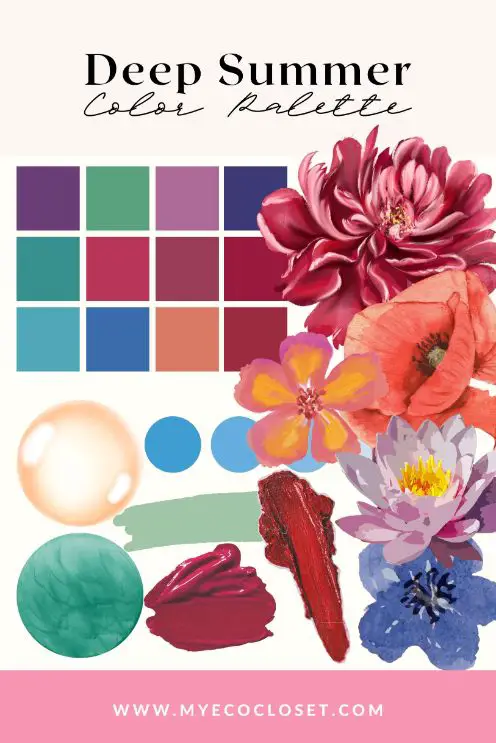

Deep Summer
In contrast, Deep Summer is defined as a richer and deeper palette. This sub-season merges the softness of the Summer season together with the depth of Winter. Put simply, it is all about darker, more saturated colors while adhering to the theme of the Summer season.
Imagine deep plums, rich teals, and dark rose shades — Deep Summer incorporates darker colors yet requires a muted approach. For example, it differs from the Soft Summer sub-season through higher contrast and depth. Yet, it remains slightly muted — more muted than True Winter or Autumn, for example.
Notable traits of the Deep Summer sub-season include:
- Hair is typically dark ash brown to soft black Eyes are usually deep – dark blue, dark brown, or deep grey
- Skin can range from fair to medium with cool undertones
- Overall appearance shows higher contrast than other Summer types
Editor’s Note: We believe that the Deep Summer sub-season leads to misclassification and inconsistency in how color seasons are recognized. Hence, we don’t acknowledge it as a distinct sub-season.


Spring or Summer Color Analysis? A Comparison
The comparison between Spring vs Summer color seasons is all about undertones and corresponding color palettes. Springs possess warm to neutral-warm undertones with a golden or peachy complexion. This means that they thrive in bright, clear colors like coral, peach, and vivid yellow that reflect the vitality of the season. What’s more, Springs possess a higher contrast between their features, which allows them to pull off bold, saturated colors.
Summers, on the other hand, feature cool to neutral-cool undertones with pink or blue hints. Due to this, they harmonize best with softer, muted shades like lavender, dusty pink, and cool sage green. Additionally, their typically low-contrast features between hair, skin, and eyes create a natural affinity for more subdued colors that mirror the gentle qualities of summer evenings.

How to Know if You’re a Summer? The Undertone Test
Understanding whether you belong to the Spring vs Summer color season comes down to identifying your natural undertones, which form the foundation when selecting colors for your personalized wardrobe. You can select your ideal color palette, which corresponds with your natural coloring based on your undertone,
Your undertone — whether cool, neutral, or warm — is key in determining which color season will best enhance your natural features.
Spring’s undertones are characterized by a radiant, golden glow — think corals, sunny yellows, and peaches — while the Summer palette features cooler, blue-based hues. To find out which undertone you carry, conduct the following test:
How to Perform the Wrist Test
- Find Natural Light: Begin by finding a well-lit area, ideally with natural light. This will provide the most accurate view of your skin’s true tone.
- Look at Your Veins: Examine the veins on the inside of your wrist. Make sure your skin is clean and free from any self-tanner or bronzer, as these can skew the results.
- Identify the color of your visible veins: If your veins appear predominantly blue, you likely have cool undertones. However, if they look more greenish, you probably have warm undertones. If they seem to be a mix of blue and green, or are simply difficult to categorize, you may have neutral undertones.
Once you’ve conducted the wrist test, you can find out where you stand in the color season dilemma. With blue veins and hence, cool undertones, you would belong to the Summer color season. Whereas, if your veins have a greenish tint, you would be classified as a Spring.

Frequently Asked Questions
To determine if you’re a Summer, check your undertones. If your veins appear blue or purple, you likely have cool undertones, which align with the Summer palette. The wrist test, conducted in natural light, can help identify whether you’re a Summer or a different color season.
Summer color analysis includes three main sub-seasons: Light Summer, True Summer, and Soft Summer. Each sub-season has its unique palette, with Light Summer favoring pastel hues, True Summer showcasing clear, cool colors, and Soft Summer embracing more muted, sophisticated tones.
Bright colors are generally too intense for the Summer color season. Summers look best in softer, muted shades that match their low contrast. Bold, saturated hues can overwhelm their natural coloring, making more subtle and cool tones like lavender or soft blues the best choices.
Start by choosing soft, cool-toned clothing like pastel blues, dusty pinks, or sage greens. Opt for neutrals that complement your skin, such as soft grays or cool beige. Layering these colors in your wardrobe helps create a harmonious look that enhances your natural features.
While Summers typically suit softer shades, darker colors can still work, especially in deeper, muted tones like charcoal gray or cool navy. However, it’s important to avoid overly bold, saturated dark colors as they may overpower your natural coloring. Stick with richer, yet soft, darker shades.
Start by incorporating one or two Summer colors into your wardrobe, such as a soft lavender top or a muted sage green accessory. Mix these colors with neutrals like cool gray or beige to see how they complement your skin tone, adjusting your look as you gain confidence.
Avoid warm, bright colors like oranges, yellows, and warm reds, as they clash with the cool undertones of the Summer palette. These hues can make your complexion appear harsh and out of balance, disrupting the natural harmony of your soft, muted coloring.

